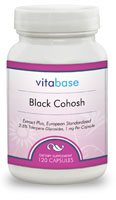| |
Black cohosh |
|
| Black cohosh is a member of the buttercup family (Ranunculaceae) native to the eastern deciduous forests of North America, ranging from southern Ontario to Georgia, north to Wisconsin and west to Arkansas. Black cohosh is also known as cimicifuga racemosa, baneberry, bugbane, black snake root, rattleroot, bugwort, and richweed. Black cohosh grows from a gnarled black root. Cohosh, an Algonquin Indian word meaning "rough", refers to the plants gnarly root structure. It has a smooth stem and big multiple leaves with jagged edges. Black cohosh likes the deep shade of moist hillsides, the home of other important medicinal plans such as goldenseal and ginseng. In summer, white flowers develop from what are called racemes. These flowers emit a stinky odor. Black cohosh has a history of traditional use among Native Americans for the treatment of a variety of disorders. Black cohosh was originally used by Native American peoples in the treatment of many conditions, especially gynecologic disorders. Contemporary uses of black cohosh are primarily geared toward the treatment of symptoms of menopause, such as hot flashes, and menopausal anxiety and depression. |
| |
Active constituents of black cohosh |
|
| Black cohosh contains triterpene glycosides (xylosides actein, cimicifugoside, and 27-deoxyacteine) and isoflavones (e.g., formononetin), phytoestrogens, isoferulic acids (substances with anti-inflammatory effects), aromatic acids, salicylic acid, tannins, resins, pantothenic acid, vitamin A , fatty acids, starches, and sugars. |
| |
Medicinal uses and health benefits of black cohosh |
|
| The primary use of black cohosh extract is for alleviation of menopausal symptoms. Black cohosh has an effect similar to estrogen, the female hormone that governs the menstrual cycle. Declining estrogen levels are responsible for the hot flashes and other
symptoms that often accompany menopause. Black cohosh contains phytoestrogens. Phytoestrogens bind to hormone receptors in the uterus, breast, and other parts of the body, and are able to mimic the hormone's effects and offset the decline in estrogen. Black cohosh has antispasmodic properties that may lessen menstrual discomforts.
Black cohosh is a safe alternative to estrogen replacement therapy (ERT) for treating symptoms of premenstrual syndrome, such as mood swings, breast tenderness, weight gain, and menstrual pain. Estrogen replacement therapy has an increased risk of breast cancer in susceptible women. By stabilizing hormone levels, the herb's phytoestrogens may even benefit women with premenstrual syndrome (PMS). Soy isoflavones, which act as phytoestrogens (plant-based estrogens) in the body, help reduce the risk of breast cancer. Back cohosh also contains an isoflavone, formononetin. black cohosh extract blocks the growth of human breast cancer cells (T-47D human breast cancer cell line).
Black cohosh is very active in the treatment of rheumatic pains, but also in rheumatoid arthritis, osteo-arthritis, in muscular and neurological pain. Black cohosh can also decrease blood pressure by opening the blood vessels in the limbs. Black cohosh has also been used for rheumatism, cough, high cholesterol levels, and hardening of the arteries. Black cohosh also often used during labor and after childbirth to soothe uterine contractions and muscle soreness. Other possible uses of black cohosh are to alleviate muscle spasms, reduce neuralgia pain, and relieve bronchial infections by stopping the compulsion to cough. |
| |
Dosage and administration of black cohosh |
|
| Black Cohosh can be taken in the form of the fresh or dried root, or as a liquid extract. It is also available commercially in capsule and tablet form. The recommended amount is 20-40 mg twice per day. One teaspoon of black cohosh tincture can be taken on a daily basis. Two to five capsules (40 mg/capsule) may be taken daily. For control of menopausal symptoms: take 40 mg of black cohosh twice a day. Begin the regimen for PMS a week to 10 days before your period. Black cohosh can be taken for up to six months, and then it should be discontinued. |
| |
Side effects, precautions, interactions |
|
| Very high dosages of black cohosh can cause vomiting, headache, dizziness, limb pains, and low blood pressure. Black cohosh is contraindicated during pregnancy because of its potential ability to stimulate uterine contraction. Black cohosh should not be taken by those with a chronic disease, or women taking birth control pills or HRT. Black cohosh may amplify the effects of blood pressure medications. The use of black cohosh with other salicylates such as aspirin or other blood-thinning medications theoretically may increase the risk of bleeding. |
|
|
|
|
